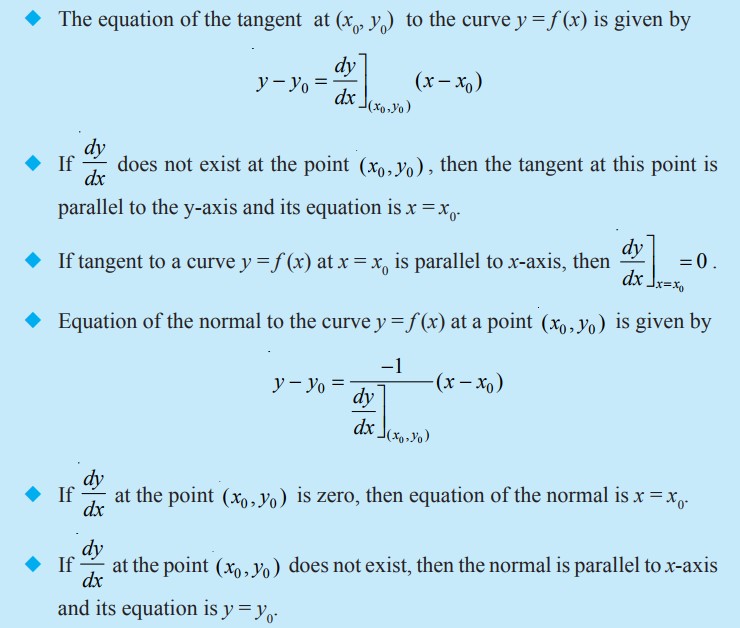Tangents and Normals

`\color{green} ✍️` The equation of a straight line passing through a given point `(x_0, y_0)` having finite slope m is given by
`y – y_0 = m (x – x_0)`
`=>` Note that the slope of the tangent to the curve y = f (x) at the point `(x_0, y_0)` is given by
`color{red}{(dy)/(dx) ]_(x_0, y_0) = f' (x_0}`. So
`\color{green} ✍️` So The equation of the tangent at `(x_0, y_0)` to the curve y = f (x) is given by
`color{green}{y – y_0 = f ′(x_0)(x – x_0)}`
`=>`Also, since the normal is perpendicular to the tangent, the slope of the normal to the curve `y = f (x)` at `(x_0, y_0)` is
`(-1)/(f'(x_0) )`. if `f' (x_0) ≠ 0 .`
`=>` Therefore, the equation of Normal to the curve` y = f (x)` at `(x_0, y_0) ` is given by
`color{green}{y - y_0 = (-1)/( f' (x_0 ) ) (x - x_0)}`
i.e., `color{green}{ (y- y_0) f' (x_0 ) + (x - x_0 ) = 0}`
`color{red}{"Key Concept :"}` If a tangent line to the curve `y = f (x)` makes an angle `θ` with `x-`axis in the positive direction, then
`color{blue}{(dy)/(dx) = "slope of the tangent" = tan θ}`
`y – y_0 = m (x – x_0)`
`=>` Note that the slope of the tangent to the curve y = f (x) at the point `(x_0, y_0)` is given by
`color{red}{(dy)/(dx) ]_(x_0, y_0) = f' (x_0}`. So
`\color{green} ✍️` So The equation of the tangent at `(x_0, y_0)` to the curve y = f (x) is given by
`color{green}{y – y_0 = f ′(x_0)(x – x_0)}`
`=>`Also, since the normal is perpendicular to the tangent, the slope of the normal to the curve `y = f (x)` at `(x_0, y_0)` is
`(-1)/(f'(x_0) )`. if `f' (x_0) ≠ 0 .`
`=>` Therefore, the equation of Normal to the curve` y = f (x)` at `(x_0, y_0) ` is given by
`color{green}{y - y_0 = (-1)/( f' (x_0 ) ) (x - x_0)}`
i.e., `color{green}{ (y- y_0) f' (x_0 ) + (x - x_0 ) = 0}`
`color{red}{"Key Concept :"}` If a tangent line to the curve `y = f (x)` makes an angle `θ` with `x-`axis in the positive direction, then
`color{blue}{(dy)/(dx) = "slope of the tangent" = tan θ}`














